CollegeAmerica - Denver Demographics & Diversity Report
Many schools pride themselves on their diversity, but what does that mean, really? College Factual analyzed the data to learn how diverse the typical college campus really is, taking into account race, gender, the ages of the students, and where they're from. Keep reading the CollegeAmerica - Denver diversity report to see how they stack up against the average.- Student Population
- Diversity Rankings
- Racial/Ethnic Diversity
- Male/Female Diversity
- Location Diversity
- Student Age Diversity
Featured schools near , edit
CollegeAmerica - Denver Student Population
How Many Students Attend CollegeAmerica - Denver?
CollegeAmerica - Denver total enrollment is approximately 72 students.
CollegeAmerica - Denver Undergraduate Population
Male/Female Breakdown of Undergraduates
The full-time CollegeAmerica - Denver undergraduate population is made up of 71% women, and 29% men.
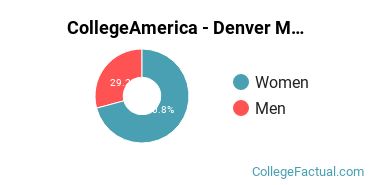
For the gender breakdown for all students, go here.
CollegeAmerica - Denver Racial/Ethnic Breakdown of Undergraduates
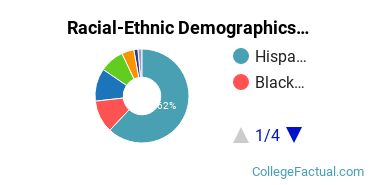
| Race/Ethnicity | Number |
|---|---|
| Hispanic | 44 |
| Black or African American | 8 |
| Unknown | 8 |
| Multi-Ethnic | 6 |
| White | 3 |
| Native Hawaiian or Pacific Islander | 1 |
| Asian | 1 |
| International | 0 |
See racial/ethnic breakdown for all students.
Below Average Ranking in Overall Diversity Nationwide
CollegeAmerica - Denver achieved a College Factual diversity rank of #2,801 out of 3,514 total schools in the ranking.
To get this overall diversity score, we looked at the combined rankings of student racial/ethnic diversity, as well as age, gender, and geographic diversity.
How Does CollegeAmerica - Denver Diversity Compare to National Averages?
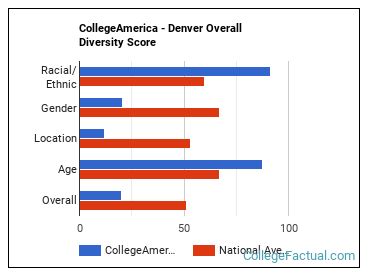
CollegeAmerica - Denver is considered below average in terms of overall diversity on a national level. Some areas of diversity in the school may be better than others.
Extremely Racially/Ethnically Diverse
CollegeAmerica - Denver is ranked 319 out of 3,790 when it comes to the racial/ethnic diversity of the students.
High racial diversity in the student body means plenty of opportunities to interact with and learn from students with different backgrounds and cultures than you.
CollegeAmerica - Denver Racial Demographics:
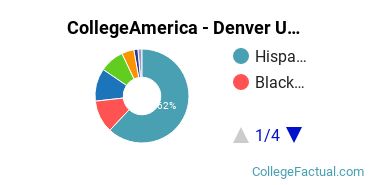
| Race/Ethnicity | Number |
|---|---|
| Hispanic | 44 |
| Black or African American | 8 |
| Unknown | 8 |
| Multi-Ethnic | 6 |
| White | 3 |
| Native Hawaiian or Pacific Islander | 1 |
| Asian | 1 |
| International | 0 |
High Racial/Ethnic Diversity Among Faculty
CollegeAmerica - Denver Faculty Racial/Ethnic Demographics:
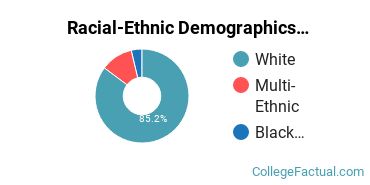
| Ethnicity | Number of Faculty |
|---|---|
| White | 23 |
| Multi-Ethnic | 3 |
| Black or African American | 1 |
| Hispanic | 0 |
| Native Hawaiian or Pacific Islander | 0 |
| International | 0 |
| Asian | 0 |
| Unknown | 0 |
Learn more about the faculty at CollegeAmerica - Denver.
Average Male/Female Ratio
CollegeAmerica - Denver ranks 3,003 out of 3,790 when it comes to gender parity on campus.
This school is more popular with women than with men.
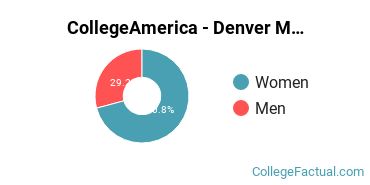
There are approximately 51 female students and 21 male students at CollegeAmerica - Denver.
Slightly Unbalanced Ratio of Male & Female Teachers
Reporting of the gender of CollegeAmerica - Denver is unknown or unavailable.
There are more female teachers than male teachers at this school.
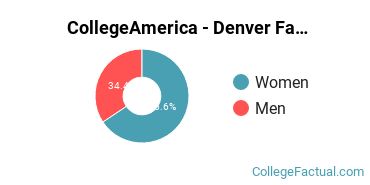
More about CollegeAmerica - Denver faculty.
There are approximately 21 female teachers and 11 male teachers.
Low Geographic Diversity
CollegeAmerica - Denver ranks 1,998 out of 2,183 when it comes to geographic diversity.
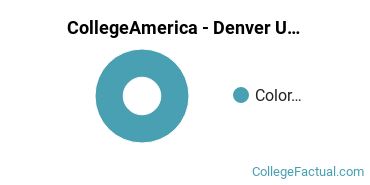
The undergraduate student body is split among 1 states (may include Washington D.C.). Click on the map for more detail.
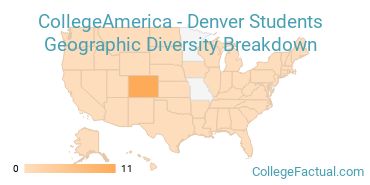
Top 5 States
| State | Amount |
|---|---|
| Colorado | 11 |
| Alaska | 0 |
| Arkansas | 0 |
| Arizona | 0 |
| California | 0 |
High Student Age Diversity
A traditional college student is defined as being between the ages of 18-21. At CollegeAmerica - Denver, 25.90% of students fall into that category, compared to the national average of 60%.
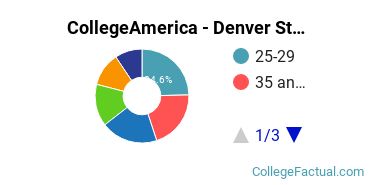
| Student Age Group | Amount |
|---|---|
| 25-29 | 34 |
| 35 and over | 28 |
| 22-24 | 27 |
| 18-19 | 20 |
| 20-21 | 16 |
| 30-34 | 13 |
| Under 18 | 0 |
Notes and References
Footnotes
*The racial-ethnic minorities count is calculated by taking the total number of students and subtracting white students, international students, and students whose race/ethnicity was unknown. This number is then divided by the total number of students at the school to obtain the racial-ethnic minorities percentage.
References
-
Department of Homeland Security Citizenship and Immigration Services
-
Read College Factual's Diversity Ranking Methodology.

